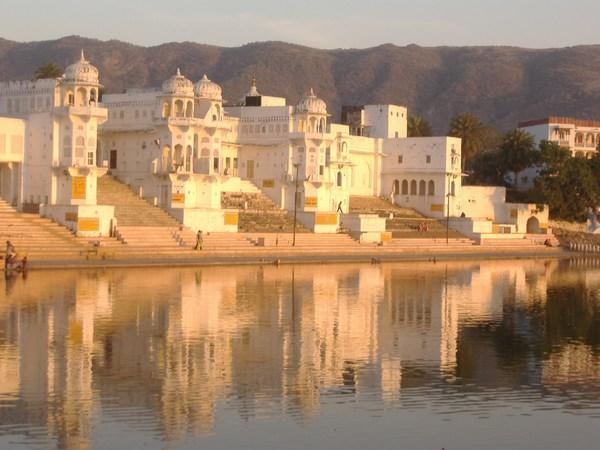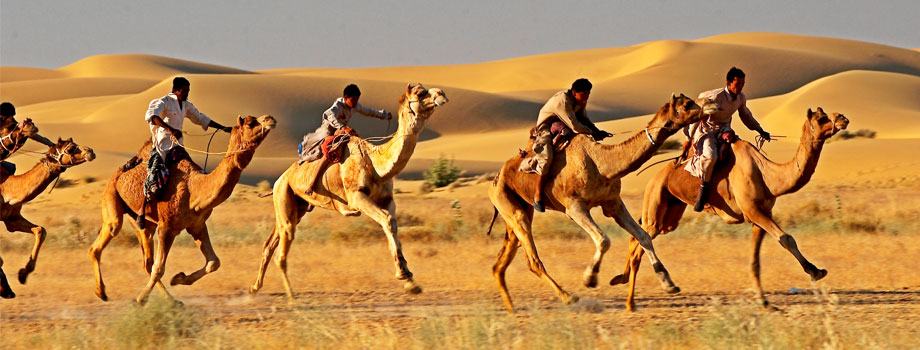-
Wild LIfe in India
India is home to many National parks and Wildlife sancturies within d Read more -
Kerla
With the Arabian Sea in the west, the Western Ghats towering 500-2700 m in Read more -
Taj Mahal
The Taj Mahal is one of the most wonderful tourism destinations in India an Read more -
Varanasi
The land of Varanasi (Kashi) has been the ultimate pilgrimage spot for Hind Read more -
Jaisalmer
The History of Jaisalmer has a charm of its own. Like all other cities of R Read more -
Amber Fort
Established in the year 2005, at JAIPUR (RAJASTHAN, India) we, "SHOW Read more
PUSHKAR
 Pushkar is a holy place, set in a valley just about 14 kilometers from the Ajmer in the northern state of Rajasthan. Pushkar is a city of temples of all size and it is to say that the only temple of Lord Brahma is located in the land of Pushkar.
Pushkar is a holy place, set in a valley just about 14 kilometers from the Ajmer in the northern state of Rajasthan. Pushkar is a city of temples of all size and it is to say that the only temple of Lord Brahma is located in the land of Pushkar. Brahma Temple
This is the only temple in the world where Lord Brahma is worshiped and the main attraction of Pushkar. The temple has a special position in Hindu pantheons. There is life-size four-armed idol of Lord Brahma - the creator in the vestibule. The temple has marble floors and stairs and coins have been put by the devotees to mark the birth or deaths of the loved ones.
Kishangarh
The miniature paintings of the Kishangarh School developed in the mid-18th century under the patronage of the royal family of Kishangarh. The hallmark of these paintings is the sharp profiles, slanted eyes, and aquiline noses that make them distinctively different from other paintings of the same genre in India. The main attractions of Kishangarh are its fort and Phool Mahal (Flower Palace), now converted into a hotel.
Kuchaman
Kuchaman, near Pushkar, is famous for its fort. A visit to Kuchaman takes you to the magic of a bygone era. The Meera Mahal depicts the life of Meera Bai in miniature paintings; the Lok Dev temple, built by Ranjit Singh to honour the sacrifices of the masses, also houses beautiful paintings of Lok Devatas such as Sant Tejaji, Sant Gogaji, Sant Pabu Rathore, Baba Ram Dev, Sant Kesaria Kanwarji, Sant Jamboji, Sant Ravi Das, Sant Kabir, Guru Nanak and Khawaja Moinu-din-chisti. Some other sites worth visiting include the Meena Bazaar (where merchants, tradesmen and craftsmen used to put up their wares for sale to the royalty) and the China Pole (with its exceptional intricately painted interiors made by a Chinese traveller narrating his experiences during his travels in India).
Mahadeva Temple
This temple was built in the 19th century and is well-known for its white marble image of Mahadeva with five faces. Also praiseworthy is the structure and the incredible ornaments with which the statue is adorned.
Nag (Yajna) Hill
It is said to be one of the oldest hills in the world. Its height is said to have been ten crores yojanas in Satya-yuga, ten lakhs yojanas in Treta-yuga, and ten thousand yojanas in Dwapura-yuga. In Kali-yuga its height is decreasing day by day because it is sinking into the earth. By the end of Kali Yuga it will almost disappear. It is said that if you visit this hill on your pilgrimages to Pushkar you will not have any interference or difficulties. On this hill is Nag Kund. The story of this hill is that Rishi Chyavan cursed Vatu, the grandson of Brahma, to become a snake on the second day of the sacrifice performed by Brahma. Vatu was cursed because at the sacrifice he released a snake that coiled around Bhrigu Muni, the father of Rishi Chyavan. After vatu begged for forgiveness, Brahma blessed him to live near this natural kund (lake) on Nag Hill. Vatu did austerities here. People who worship here on the 5th day in Krishna Paksha of Sravana (July/Aug) are said to get their desires fulfilled. Agastya Muni's residence is said to be a cave on Nag Hill. It is about 2 km from Senior Pushkar.
Pushkar Bazaar
A bustling bazaar, the Pushkar local market offers tourist as well pilgrimage related products. A range of souvenirs could be purchased including the Rajasthani costumes, jewellery, embroidered fabrics, decorative pieces and groovy accessories. The bazaar becomes a hub of activity during the annual Pushkar Fair.
Pushkar Fair
The most important reason of Pushkar being on the international travel map is Pushkar Fair. The fair is held every year in the month of November during the Kartik Purnima (day of full moon) when hundreds of thousands of people take a holy dip in the sacred Pushkar Lake. This is also an occasion to organize the largest camel fair in the world.
Pushkar Lake
Pushkar Lake is another important attraction of Pushkar and it has immense significance for the followers of Hinduism. According to the legends, the lake was dedicated to Lord Brahma after a lotus fell from his hands and dropped into this picturesque valley. A lake sprang up on the same spot latter on which is considered holy. The entire lake is supposed to be surrounded by 500 temples, 52 palaces, and 52 ghats. On the occasion of Kartik Purnima in November every year, devotees take holy bath in the lake and a fair is organized, known world over as the Pushkar Fair.
Rangji Temple
The Rangji Temple is dedicated to Vishnu, the Preserver of the Hindu Trinity. Built in the style of the South Indian temples, it houses two massive structures of dwarpalas (gatekeepers) in front of the main gate. The temple has an image of Garuda, the mount of lord Vishnu.
Roopangarh Fort
The Roopangarh Fort was constructed by King Roop Singh of Kishangarh in 1648 exclusively for defence. Originally a nine-turreted fort, new additions were continuously made to it in couse of time. The different styles of architecture can be distinctly observed in the fort. Kishangarh and Roopangarh are both situated at a distance of around 100 km from Jaipur.
Sambhar
Declared as a wetland of international importance, Sambhar Lake is a wonderful place to visit near Pushkar. Apart from being a place where horizons stretch to infinity, where water and sky merge in a shimmer of gauzy blue, the Sambhar Lake is also regarded as the bird watchers\’ paradise. The lake is home to about 140 species of birds, including land birds. Legend has it that Raja Yayati, a descendant of Lord Brahma, married Devyani, daughter of Shukracharya (the guru of demons) who lived by the lake.
Savitri Temple
It is situated on the hill behind the Brahma Temple, and a long series of steps has to be climbed to reach it. It gives a beautiful panoramic view of the Pushkar lake, and the surrounding sand dune villages. According to a legend, while Brahma was performing a sacred ritual his wife Savitri was not present. Since the presence was essential for the ritual, Brahma hastily married a local maiden, Gayatri. When Savitri heard about this, she flew into a rage and cursed Bramha that he would not be worshipped anywhere accept Pushkar.
Varah Temple
Being built in the 12th century, the Varah Temple was one of the many temples destroyed by Emperor Aurangzeb. It is said that he particularly detested the life-size image of Varah, the god with the head of a wild boar and the body of a man. Later in 1727, Raja Sawai Jai Singh of Jaipur reconstructed it. The temple has elegant carvings and sculptures, besides the richly ornamented image house.





